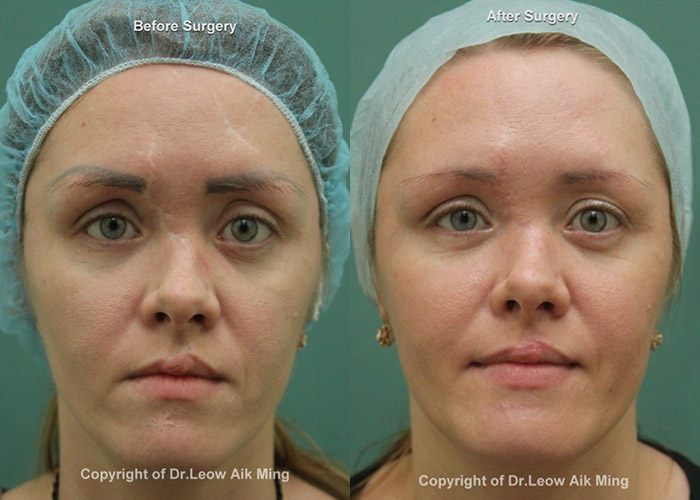INTRODUCTION
Scar is a biological process of wound healing in the skin and other tissues of the body. A normal scar matures or remodels over 12-18 months, resulting in a final scar that has a tensile strength of 70-80% of uninjured skin. The amount of scarring may be determined by the wound size, location and depth, degree of wound contamination, person’s age, heredity, skin characteristics including skin colour and techniques of wound closure. Patients who present with unfavourable scars typically have wounds that:
- Demonstrate an unfavourable configuration with respect to length and direction of RSTLs (relax skin tension lines)
- Have undergone pathologic healing processes
- Situated in unfavourably cross anatomic regions
- Are subjected to constant deforming contractile forces because of underlying anatomy especially at area of excessive movements or joint areas
- Are deeply traumatic
Types of unfavourable scars:
- Hypertrophy scar – occurs when the body produces collagen excessively causing the scar to rise above the surrounding skin.
- Keloid – is a serious form of scarring because the scar may progressively overgrow the original wound margins to involve adjacent tissue.
- Atrophy scar – takes the form of a sunken recess in the skin, which has a pitted appearance due to loss of underlying structures supporting the skin, such as fat or muscle.
- Stretch marks – are caused when the skin is stretched rapidly (during pregnancy, significant weight gain or adolescent growth spurts) or when skin is put under tension during the healing process, (usually near joints).
Scar revision consists of spectrum of surgical techniques and other modalities aimed to reduce or improve the appearance of scars and restores function caused by an injury, wound, or previous surgery.
The timing of scar revision depends on a variety of factors, including type and location of injury and the psychological readiness of the patient. One popular practice adopts a 6 to 12-month waiting period following initial injury, but experience shows that this waiting period must be individualized because an earlier approach may be undertaken.
Treatment options for unfavourable scars may vary depending on the type and degree of scarring. They can be classified into:
- Simple topical treatments and pressure therapy – topical ointments (silicone), pressure garment.
- Minimally invasive procedures – chemical peels, dermabrasion, laser, steroid injections, filler or fat graft injections.
- Surgical revision procedures – ranging from simple scar excision to advanced techniques (tissue expansion or flap reconstruction) in wound closure.
It is important to understand that a scar cannot be completely erased. However, scar revision procedure is meant to minimize the scar so that it is more consistent with the surrounding skin tone and texture. Thus, providing a more pleasing cosmetic result or improve a scar that has healed poorly.
PRE-OPERATIVE EVALUATION
Communication is vital in order to achieve the patient’s goals. During the initial consultation, patients will have the opportunity to discuss their goals and desirable results with the plastic surgeon. The plastic surgeon will work closely with the patients to reach an agreement about the expectations from the surgical procedures involved and their long term benefits. Every patient is different, therefore a specific treatment regimen is planned to suit an individual’s need. The preoperative evaluation for scar revision includes:
- Discussion about reasons for corrective surgery, patients’ expectations and desired outcome
- Medical conditions, drug allergies and previous medical or surgical treatment
- Use of current medications, vitamins, herbal supplements, alcohol, tobacco and drugs
- Discussion on anaesthesia and its risks
- Physical examination
- Scar examination including detailed assessments of their size and shape and surrounding skin quality
- Photography for preoperative and postoperative evaluation
RISKS AND SAFETY
The decision to have scar revision surgery is extremely personal. Patients have to consider if the benefits will achieve their goals and if the risks and potential complications are acceptable. Therefore, it is important for patients to understand that every surgical procedure has its own complications and down time. However, if a patient is assessed properly before the surgery and postoperative care is given adequately, these risks can be eliminated or reduced.
Some of the common risks of scar revision surgery:
- Infection
- Bleeding
- Poor wound healing
- Wound breakdown
- Skin discoloration
- Skin contour irregularities
- Skin sensitivity
- Swelling due to blood clot or fluid accumulation
- Injury to deeper structures such as nerves, blood vessels or muscles
- Implant failure or infection (if implant such as tissue expander is used)
- Possibility of revision or staged surgery
- Anaesthesia risks
POST-OPERATIVE EXPECTATIONS
Postoperative expectations following scar revision procedures vary depending upon the invasiveness of the procedure. Minimal invasive procedures (chemical peels, dermabrasion, laser, steroid injections, filler or fat graft injections) or simple scar revision surgery can be done as out-patient basis. These procedures have shorter recovery time and patients may resume their routine activities with 3 -5 days after the procedures. On the other hand, scar revision surgery that requires insertion of tissue expander or flap surgery may need a longer recovery period. The initial healing phase for scar revision surgery may include localized swelling, discoloration or discomfort and this may take 1 to 2 weeks. The healing process will continue for several weeks to months for the new scar to fully restore and fade. The final result of the scar revision surgery is usually long-lasting.
– COPYRIGHT OF DR LEOW AIK MING



